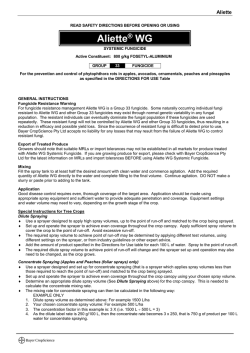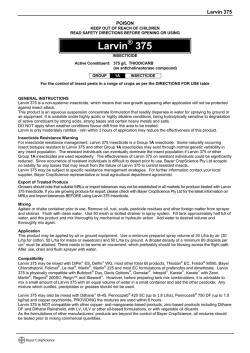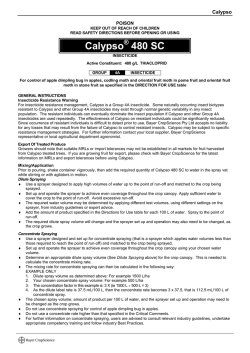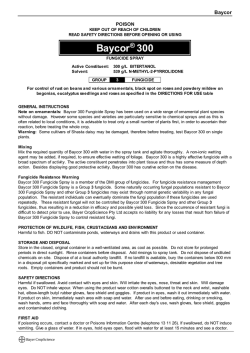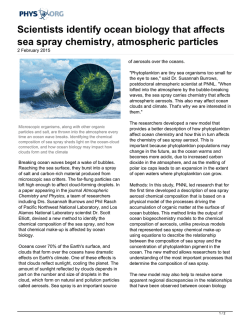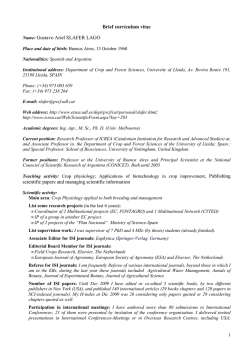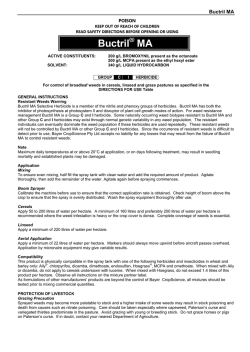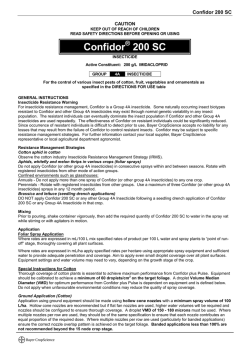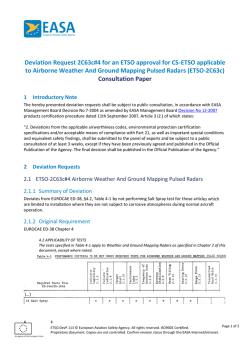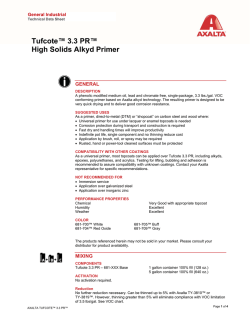
Flint® 500 WG - Bayer CropScience
Flint 500 WG CAUTION KEEP OUT OF REACH OF CHILDREN READ SAFETY DIRECTIONS BEFORE OPENING OR USING Flint® 500 WG FUNGICIDE Active Constituent: 500 g/kg TRIFLOXYSTROBIN GROUP 11 FUNGICIDE For the control of certain diseases of apples, bananas, grapevines, pears and strawberries as specified in the DIRECTIONS FOR USE table GENERAL INSTRUCTIONS Fungicide Resistance Warning Flint 500 WG is a member of the strobilurin group of fungicides. For fungicide resistance management Flint 500 WG is a Group 11 fungicide. Some naturally occurring individual fungi resistant to the product and other Group 11 fungicides may exist through normal genetic variability in any fungal population. The resistant individuals can eventually dominate the fungal population if these fungicides are used repeatedly. These resistant fungi will not be controlled by this product or other Group 11 fungicides, thus resulting in a reduction in efficacy and possible yield loss. Since the occurrence of resistant fungi is difficult to detect prior to use, Bayer CropScience Pty Ltd accepts no liability for any losses that may result from the failure of this product to control resistant fungi. Resistance Management Strategy Flint 500 WG may be subject to specific resistance management strategies. For further information contact your local supplier, Bayer CropScience representative, local agricultural department agronomist or visit www.croplifeaustralia.org.au. Integrated Pest Management Flint 500 WG is suitable for use in IPM programmes. Flint 500 WG is harmless to predators in situations where integrated mite control is practised. Compatibility Apples, pears and grapevines: DO NOT mix Flint 500 WG with surfactants as damage to flowers and russetting may occur. Do not mix concentrates together but add each to the spray tank separately. As formulations of other manufacturers' products are beyond the control of Bayer CropScience, all mixtures should be tested prior to mixing commercial quantities. As changes in climatic conditions can alter the sensitivity of plants to mixtures of sprays, Bayer CropScience cannot be responsible for the behaviour of such mixtures. Bananas: DO NOT mix Flint 500 WG with any additive other than high quality (narrow-range) water miscible mineral crop oils. As formulations of mineral spray oils are beyond the control of Bayer CropScience please refer to Bayer CropScience, your chemical reseller, aerial applicator or the manufacturer of the oil to ensure that it is physically and biologically compatible with Flint. IMPORTANT – if using Flint with a mineral crop oil in crops with exposed (unbagged) bunches, please refer to the Special Warning section following. Special Warning (bananas) There are certain conditions when the surface of recently emerged fruit is particularly prone to marking damage from spray applications. In circumstances where application will be made to very rapidly growing fruit in hot conditions with strong direct light, it is recommended that all emerged bunches be bagged prior to spraying to minimise risk of fruit marking. If using Flint with a mineral oil in banana blocks with un-bagged bunches, please contact Bayer CropScience, your chemical reseller or aerial applicator for up to date information regarding the oil formulations recommended by Bayer CropScience. Flint 500 WG Mixing and Application Apples, Pears and Grapes Add the required amount of product directly to the spray tank and mix well. Apply only as a ground application, by dilute or concentrate spray methods. Tank Mixing: When mixing Flint 500 WG and other water dispersible granule (WG) or wettable powder (WP) formulations, ensure they are added and mixed well prior to adding emulsifiable concentrate (EC) or suspension concentrate (SC) products. Wettable powder (WP) formulations should be pre-mixed separately and then added to the spray tank. Dilute Spraying (apples, pears and grapevines) ♦ Use a sprayer designed to apply high volumes of water up to the point of run-off and matched to the crop being sprayed. ♦ Set up and operate the sprayer to achieve even coverage throughout the crop canopy. Apply sufficient water to cover the crop to the point of run-off. Avoid excessive run-off. ♦ The required water volume may be determined by applying different test volumes, using different settings on the sprayer, from industry guidelines or expert advice. ♦ Add the amount of product specified in the Directions for Use table for each 100 L of water. Spray to the point of run-off. ♦ The required dilute spray volume will change and the sprayer set up and operation may also need to be changed, as the crop grows. Concentrate Spraying (apples, pears and grapevines) ♦ Use a sprayer designed and set up for concentrate spraying (that is a sprayer which applies water volumes less than those required to reach the point of run-off) and matched to the crop being sprayed. ♦ Set up and operate the sprayer to achieve even coverage throughout the crop canopy using your chosen water volume. ♦ Determine an appropriate dilute spray volume (See Dilute Spraying above) for the crop canopy. This is needed to calculate the concentrate mixing rate. ♦ The mixing rate for concentrate spraying can then be calculated in the following way: EXAMPLE ONLY 1. Dilute spray volume as determined above: For example 1000 L/ha 2. Your chosen concentrate spray volume: For example 250 L/ha 3. The concentration factor in this example is: 4 X (i.e. 1000 L ÷ 250 L= 4) 4. If the dilute label rate is 10 g/100 L, then the concentrate rate becomes 4 x 10, that is 40 g/100 L of concentrate spray. ♦ The chosen spray volume, amount of product per 100 L of water, and the sprayer set up and operation may need to be changed as the crop grows. ♦ Do not use a concentrate rate higher than that specified in the Critical Comments. For further information on concentrate spraying, users are advised to consult relevant industry guidelines, undertake appropriate competency training and follow industry Best Practices. Mixing and Application Bananas Add the required amount of product to half of the water in the spray tank. Then add the water miscible mineral crop oil (if using) and the remainder of the water and mix well. If the banana crop is destined for export, the bananas should be bagged prior to spraying to ensure that MRLs of trifloxystrobin are below the MRLs for export destinations. Aerial application (bananas) Apply at least 20 L of spray mixture per hectare for aerial application. DO NOT apply within 10 metres upwind of aquatic areas including, natural streams, rivers and waterways. Mixing difficulties may occasionally be encountered when using low application volumes in combination with very soft water. The problem can be readily alleviated by the addition of a suitable buffering agent to the spray tank. Strawberries Add the required amount of product to half of the water in the spray tank. Then add the remainder of the water and mix well. Apply at least 500 L of spray mixture per hectare. Flint 500 WG Export of Treated Produce Maximum Residue Limits (MRLs) may be lower or not be established in export markets. Check with your Industry Association or Bayer CropScience prior to using this product on crops destined for export. Bagging of bunches prior to spraying will reduce the likelihood of detectable residues occurring in bananas. Apples, Pears, Strawberries and Table Grapes: If you are growing apples, pears or strawberries for export, or table grapes for export (either fresh or dried), see the comment under Export Harvest Interval. Wine Grapes: Where this product will be used on grapes that will be used to produce wine destined for export markets, seek advice from the Australian Wine Research Institute or Bayer CropScience to ensure the wine will meet the requirements of the intended importing country. PRECAUTIONS Re-entry DO NOT allow entry into treated areas until the spray has dried, unless wearing cotton overalls buttoned to the neck and wrist, a washable hat and chemical resistant gloves. Clothing must be laundered after each day’s use. Caution DO NOT use human flaggers/markers unless they are protected by engineering controls such as enclosed cabs. PROTECTION OF LIVESTOCK Low hazard to bees – product may be applied to plants at any time of day. DO NOT allow stock to graze in any treated areas. PROTECTION OF WILDLIFE, FISH, CRUSTACEANS AND ENVIRONMENT Dangerous to fish and other aquatic organisms. DO NOT apply if heavy rain or storms are forecast to occur within the immediate areas. DO NOT apply under weather conditions or from spraying equipment which could be expected to cause spray to drift onto adjacent areas, particularly streams, rivers or other bodies of water. DO NOT contaminate streams, rivers or waterways with the chemical or used containers. STORAGE AND DISPOSAL Store in closed original container in a dry, well ventilated place as cool as possible out of direct sunlight. The method of disposal of the container depends on the container type. Read the STORAGE AND DISPOSAL instructions on the label that is attached to the container. SAFETY DIRECTIONS Will irritate the skin. Avoid contact with skin. When opening the container, preparing spray and using the prepared spray, wear cotton overalls buttoned to the neck and wrist, a washable hat and elbow-length PVC gloves. Wash hands after use. After each day's use, wash gloves and contaminated clothing. FIRST AID If poisoning occurs, contact a doctor or Poisons Information Centre (telephone 13 11 26). MATERIAL SAFETY DATA SHEET Additional information is listed in the Material Safety Data Sheet, which can be obtained from www.bayercropscience.com.au. EXCLUSION OF LIABILITY This product must be used strictly as directed, and in accordance with all instructions appearing on the label and in other reference material. So far as it is lawfully able to do so, Bayer CropScience Pty Ltd accepts no liability or responsibility for loss or damage arising from failure to follow such directions and instructions. APVMA Approval No.: 53871/58078 ® ® Flint and Folicur are Registered Trademarks of Bayer. FOR 24 HOUR SPECIALIST ADVICE IN EMERGENCY ONLY PHONE 1800 033 111 Flint 500 WG DIRECTIONS FOR USE Restraints DO NOT mix this product with any type of spray additive in any crop, with the exception of water miscible crop oil in bananas only. DO NOT apply by air to apples, pears, grapevines or strawberries. CROP Apples Pears DISEASE Pow dery mildew of apples Protective control of: Apple scab, Pear scab RATE Dilute spraying 10 g/100 L w ater Concentrate Spraying Refer to the Mixing/ Application section. CRITICAL COMMENTS This use is subject to an CropLife Australia resistance management strategy. Follow a complete disease management program for scab by rotating w ith fungicides from unrelated chemical groups according to the CropLife Australia fungicide resistance management guidelines. Flint 500 WG should be applied as a block of three treatments at 7 to 10 day intervals over flow ering and into early fruit development. Use short spray intervals w hen disease pressure is high. DO NOT apply more than three applications of Flint 500 WG per season (part of the CropLife Australia resistance management strategy). When used over flow ering, apply Flint 500 WG alone. Apply w ith a DMI (Group 3) scab fungicide if intervals are longer than 10 days. Apply by dilute or concentrate spraying equipment. Apply the same amount of product to the target crop w hether applying this product by dilute or concentrate spraying methods. Do not use in equipment that requires rates greater than 50 g/100 L of w ater (5X). Grapevines Pow dery mildew , Suppression of dow ny mildew Dilute spraying 15 g/100 L w ater Concentrate Spraying Refer to the Mixing/ Application section. Apply thoroughly as part of a pow dery mildew spray program. The critical crop timing for pow dery mildew control is from early flow ering to pre bunch closure.DO NOT allow spray intervals in the above program to exceed 14 days. DO NOT apply more than tw o applications of Flint 500 WG per season. Apply by dilute or concentrate spraying equipment. Apply the same amount of product to the target crop w hether applying this product by dilute or concentrate spraying methods. Do not use in equipment that requires rates greater than 75 g/100 L of w ater (5X). Do not apply in w ater volumes less than 250 L/ha. This use is subject to a CropLife Australia resistance management strategy. For further information refer to the CropLife Australia w ebsite: w w w .croplifeaustralia.org.au Flint 500 WG CROP Bananas (Qld, NSW, WA & NT only) DISEASE Yellow Sigatoka, black Sigatoka, cordana leaf spot RATE 150 g/ha (plus a high quality w ater miscible mineral crop oil at up to 5 L/ha*) CRITICAL COMMENTS This use is subject to a CropLife Australia resistance management strategy. Flint should be applied as part of a regular program of fungicide sprays, alternating w ith fungicides from different chemical groups. For optimum disease control maintain thorough de-leafing practices, in accordance w ith industry guidelines, to reduce disease inoculum. Old leaves, and leaves w ith advanced lesions should be removed, or infected parts of the leaf removed, prior to the application of Flint. Intervals betw een fungicide applications generally should be 14-21 days, but should be modified for locality, disease conditions, and leaf emergence grow th rates. Flint should be diluted w ith sufficient w ater to ensure thorough coverage of all leaf surfaces (minimum 20 L/ha spray volume w hen applied by air). *When conditions are favourable for disease development, a high quality (narrow -range) mineral crop oil should be applied w ith Flint. Refer to the Compatibility section of the label for information on mineral crop oils. Use the maximum rate of oil appropriate to the conditions at time of spraying, up to 5 L/ha. Flint should only be applied w ithout oil during dry conditions or w hen disease pressure is low . Do not apply consecutive Flint applications. Apply a minimum of 2 sprays from a different activity group, e.g. Folicur ® 430 SC, betw een sprays of Flint or other Group 11 fungicides. In the Tropics (North Qld, NT and Northern WA) DO NOT apply Group 11 sprays in the months of May, June, July, August and September. Apply a maximum of 4 applications of Flint (or other Group 11 fungicides) to any banana block in a 12-month period. Flint should not be used w here foliar diseases are in an advanced stage of development. Straw berries Pow dery mildew (Sphaerotheca macularis) Dilute spraying 20-25 g/100 L Use w hen spray volume exceeds 800 L/ha OR Low volum e 200-300 g/ha Use w hen spray volume is less than 800 L/ha Do not apply volumes less than 500 L/ha This use is subject to a CropLife Australia resistance management strategy. Reduce background levels of disease by removing infected plant debris and/or rotted fruit throughout the season. A fungicide program for the control of pow dery mildew should commence from early flow ering. Apply Flint strategically as part of a program w hen conditions favour disease development. DO NOT apply consecutive Flint treatments, including from one season to the next. Alw ays alternate Flint w ith a registered fungicide of a different chemical group. Do not allow the interval betw een Flint and an alternative group fungicide to exceed 10 days. Use a shorter application interval w hen disease pressure is high. Ensure adequate penetration of the canopy and coverage of foliage and flow ers and/or fruit. DO NOT apply more than 3 applications of Flint 500 WG per season. Use the higher rate w here disease pressure is high. Addition of a non-ionic w etting agent is not required. NOT TO BE USED FOR ANY PURPOSE, OR IN ANY MANNER, CONTRARY TO THIS LABEL UNLESS AUTHORISED UNDER APPROPRIATE LEGISLATION WITHHOLDING PERIODS: Apples, pears, grapes: Bananas: Strawberries: DO NOT HARVEST FOR 5 WEEKS AFTER APPLICATION NOT REQUIRED WHEN USED AS DIRECTED DO NOT HARVEST FOR 1 DAY AFTER APPLICATION EXPORT HARVEST INTERVALS: Contact Bayer CropScience for the latest information on Export Harvest Intervals.
© Copyright 2025
